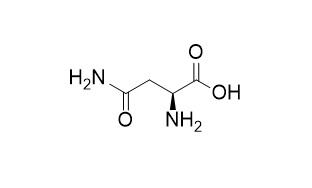L-Asparagine
L-asparaginase is effective in suppressing cellular immunity and inducing remission in patients with acute lymphocytic leukemia, mainly a non-B-cell disease.The enhancing action of L-asparagine upon insulin release evoked by L-leucine is attributable to an increased generation rate of cytosolic NADPH rather than any increase in nutrients oxidation.
Inquire / Order:
manager@chemfaces.com
Technical Inquiries:
service@chemfaces.com
Tel:
+86-27-84237783
Fax:
+86-27-84254680
Address:
1 Building, No. 83, CheCheng Rd., Wuhan Economic and Technological Development Zone, Wuhan, Hubei 430056, PRC
Providing storage is as stated on the product vial and the vial is kept tightly sealed, the product can be stored for up to
24 months(2-8C).
Wherever possible, you should prepare and use solutions on the same day. However, if you need to make up stock solutions in advance, we recommend that you store the solution as aliquots in tightly sealed vials at -20C. Generally, these will be useable for up to two weeks. Before use, and prior to opening the vial we recommend that you allow your product to equilibrate to room temperature for at least 1 hour.
Need more advice on solubility, usage and handling? Please email to: service@chemfaces.com
The packaging of the product may have turned upside down during transportation, resulting in the natural compounds adhering to the neck or cap of the vial. take the vial out of its packaging and gently shake to let the compounds fall to the bottom of the vial. for liquid products, centrifuge at 200-500 RPM to gather the liquid at the bottom of the vial. try to avoid loss or contamination during handling.
Cosmetics2025, 12(3), 108
Int J Mol Sci.2022, 23(21):13406.
J Agric Food Chem.2020, 68(51):15164-15175
J.Korean Soci. Food Sci. Nutri.2024, 53(11):1166-1177
Biochem Biophys Res Commun.2020, 522(1):40-46
Plants (Basel).2023, 12(6):1259.
Molecules.2023, 28(8):3474.
Applied Biological Chemistry2020, 63:37.
Planta Med.2019, 85(3):217-224
Biol Pharm Bull.2018, 41(1):65-72
Related and Featured Products
BBA - General Subjects, 1984, 797(2):194-202.
The stimulus-secretion coupling of amino acid-induced insulin release metabolic interaction of L-asparagine and L-leucine in pancreatic islets.[Reference:
WebLink]
1. Because L-Asparagine augments insulin release evoked by L-leucine, the metabolism of these two amino acids was investigated in rat pancreatic islets.
METHODS AND RESULTS:
2. L-Leucine inhibited the uptake and deamidation of L-Asparagine, but failed to exert any obvious primary effect upon the further catabolism of aspartate derived from exogenous asparagine. 3. L-Asparagine augmented the oxidation of L-leucine, and effect possibly attributable to activaion of 2-ketoisocaproate dehydrogenase. 4. The association of L-Asparagine and L-leucine exerted a sparing action on the utilization of endogenous amino acids, so that the integrated rate of nutrients oxidation was virtually identical in the sole presence of L-leucine and simultaneous presence of L-Asparagine and L-leucine, respectively.
CONCLUSIONS:
5. It is proposed that the enhancing action of L-Asparagine upon insulin release evoked by L-leucine is attributable to an increased generation rate of cytosolic NADPH rather than any increase in nutrients oxidation.
J Natl Cancer Inst, 1977, 59(4):1061-1063.
L-asparagine requirements of human T-lymphocytes and B-lymphocytes in culture.[Reference:
WebLink]
METHODS AND RESULTS:
The characterization of two human T-lymphocyte lines revealed that they required exogenous L-Asparagine for cell growth, whereas all four B-cell lines studied were L-Asparagine independent. T-cells were 800-2,000 times more sensitive to Escherichia coli L-asparaginase than were B-cells. The cytotoxic effects of a high concentration of L-asparaginase on B-cells were not related to the hydrolysis of L-Asparagine but were due to heat-labile and heat-resistant substances in the enzyme. The findings were consistent with reports that L-asparaginase is effective in suppressing cellular immunity and inducing remission in patients with acute lymphocytic leukemia, mainly a non-B-cell disease.
CONCLUSIONS:
Thus these cell lines provide in vitro models for the study of a nutritional approach to chemotherapy or immunotherapy.
Chinese Journal of Experimental Traditional Medical Formulae, 2012.
Dynamic Accumulation of L-asparagine in Roots of Changium smyrnioides from Different Collection Month Cultivated in Jiangsu[Reference:
WebLink]
To study the dynamic accumulative law of L-Asparagine in Changium smyrnioides from different collection month.
METHODS AND RESULTS:
L-Asparagine in roots of C.smyrnioides from different collection month were derived with o-phthaldialdehyde(OPA) in pre-column,and separated by RP-HPLC.L-Asparagine was determined.1 mL sample solution,1 mL colorimetric reagent and 5 mL borax buffe(0.2 mol · L-1,pH 10.5) were settled to the volume of 10 mL and reacted 20 min;mobile phase A was 1.35% sodium acetate buffer(pH 7.3),mobile phase B was 1.35% sodium acetate(pH 7.2)-acetonitri-methanol(100∶175∶225),0-20 min A∶B(93∶7),20-25 min A∶B(0∶100),at the rate of 1 mL · min-1.The temperature of column was 40 ℃ and the wavelength was at 333 nm. The content of L-Asparagine was 0.26%-1.87% in 100-1 000 mg · L-1.
CONCLUSIONS:
The contents of L-Asparagine was higher in May-August,January than other months.
(3S,5S,E)-1,7-Diphenylhept-1-ene-3,5-diol
Catalog No: CFN95195
CAS No: 87095-75-8
Price: $318/5mg
15-Methoxy-16-oxo-15,16H-strictic acid
Catalog No: CFN95261
CAS No: 1356388-38-9
Price: $368/5mg
2-Methoxy-1,4-naphthoquinone
Catalog No: CFN95269
CAS No: 2348-82-5
Price: $70/20mg
Fortunellin-6''-beta-D-glucopyranoside (Acacetin-7-O-[2''-O-rhamnosyl-6''-O-glucosyl]-glucoside)
Catalog No: CFN95315
CAS No: 1218774-64-1
Price: $318/5mg
5,6,7,3',4',5'-Hexamethoxyflavanone
Catalog No: CFN95376
CAS No: 74064-17-8
Price: $318/10mg
(2S)-5,7,3',4'-tetramethoxyflavanone
Catalog No: CFN95406
CAS No: 74628-43-6
Price: $318/10mg
Senkyunolide N
Catalog No: CFN95449
CAS No: 140694-58-2
Price: $318/10mg
Barbaloin-related compound B
Catalog No: CFN95455
CAS No: 473225-22-8
Price: $318/5mg
Giganteone C
Catalog No: CFN95484
CAS No: 1071223-56-7
Price: $318/10mg
Campneoside II
Catalog No: CFN95498
CAS No: 95587-86-3
Price: $318/10mg



